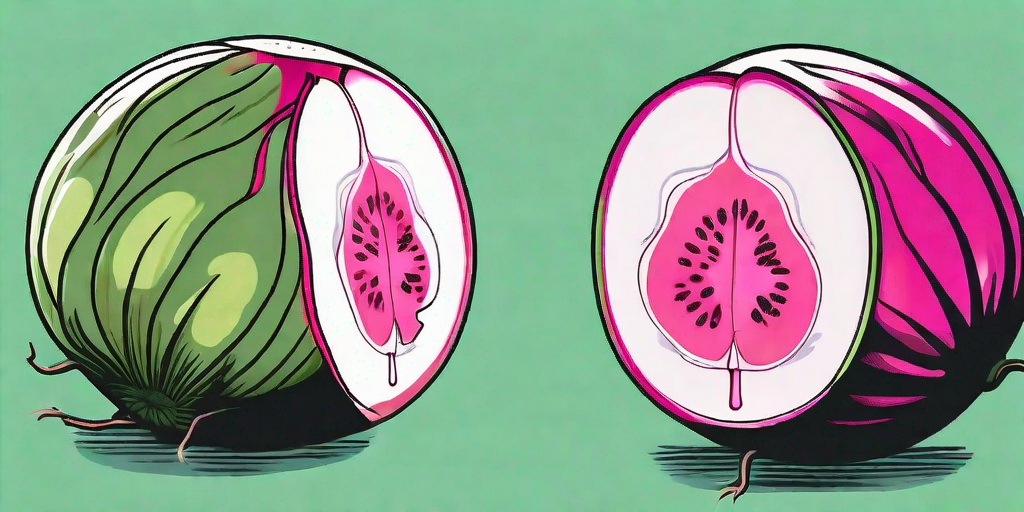
Welcome to the wonderful world of watermelon radishes! These vibrant veggies are not only a feast for the eyes but also a delight for the taste buds. They're a bit like the unicorns of the radish family - rare, beautiful, and a little bit magical. But don't worry, you don't need a green thumb or a magic wand to grow them. All you need is a little patience, a sprinkle of care, and this comprehensive guide. So, let's dive in!
The Watermelon Radish: A Brief Introduction
The watermelon radish, also known as the Rooseheart radish or the Red Meat radish, is a member of the Brassicaceae family. This cheeky little root vegetable is native to China, where it's known as 'shinrimei'. But don't let the exotic name fool you, growing these radishes is as easy as pie... a very healthy, low-calorie pie.
What sets the watermelon radish apart is its unique appearance. On the outside, it's all business with its greenish-white skin. But slice it open, and you'll be greeted by a vibrant pink-red interior that's reminiscent of a juicy watermelon. But don't expect a sweet, fruity taste. These radishes pack a peppery punch with a slight hint of sweetness.
How to Grow Watermelon Radishes
Choosing the Right Time
Timing is everything when it comes to growing watermelon radishes. They are cool-season crops, which means they prefer the chillier temperatures of spring and fall. In fact, a little frost can actually enhance their flavor. So, if you're looking to add a little spice to your frosty mornings, these radishes have got you covered.
It's best to plant the seeds 4-6 weeks before the last expected spring frost or 6-8 weeks before the first fall frost. This gives the radishes enough time to mature and develop their signature flavor.
Preparing the Soil
Watermelon radishes aren't picky eaters, but they do appreciate a well-prepared meal. They prefer loose, well-draining soil with a pH between 6.0 and 7.0. So, before you plant your seeds, make sure to loosen the soil with a garden fork and add some compost for extra nutrients. Your radishes will thank you for it.
Also, remember to remove any rocks or debris from the soil. These can obstruct the growth of the radishes and result in misshapen roots. And while we love all radishes, regardless of their shape or size, it's always nice to have a good-looking crop.
Planting the Seeds
When it comes to planting, watermelon radishes like their personal space. So, sow the seeds about 1/2 inch deep and 1-2 inches apart. This gives the radishes enough room to grow and develop. If you're planting multiple rows, keep them about 12 inches apart.
After planting, water the seeds thoroughly and keep the soil moist until the radishes germinate. This usually takes about 3-7 days. Once the radishes have sprouted, water them regularly but avoid overwatering. Too much water can lead to root rot, and nobody wants that.
Harvesting and Storing Watermelon Radishes
Watermelon radishes are usually ready to harvest 50-60 days after planting. You'll know they're ready when the tops of the radishes are about 1 inch in diameter. But don't rush to harvest all your radishes at once. They can stay in the ground for a while and will actually become sweeter with a light frost.
Once harvested, you can store the radishes in the refrigerator for up to a month. Just remove the leaves and store the radishes in a plastic bag with a little bit of moisture. This will keep them crisp and fresh.
Enjoying Your Watermelon Radishes
Now comes the best part - eating your watermelon radishes! These versatile veggies can be enjoyed raw, pickled, or cooked. They add a pop of color and a peppery kick to salads, sandwiches, and stir-fries. You can even roast them for a delicious side dish.
Here's a simple recipe to get you started:
- Slice the radishes thinly.
- Drizzle with olive oil and sprinkle with sea salt.
- Roast at 375°F (190°C) for about 15 minutes or until crispy.
- Enjoy as a snack or a side dish.
Frequently Asked Questions
Are watermelon radishes spicy?
Watermelon radishes have a peppery taste, but they're not as spicy as some other radish varieties. The spice level can vary depending on the growing conditions and the size of the radish. Generally, larger radishes tend to be milder.
Can I grow watermelon radishes in a container?
Absolutely! Watermelon radishes can be grown in containers that are at least 12 inches deep. Just make sure the container has good drainage and the radishes have enough room to grow.
Do watermelon radishes need full sun?
Watermelon radishes prefer full sun, but they can tolerate partial shade. However, too much shade can result in slower growth and less flavorful radishes.
So there you have it, folks! Everything you need to know about growing and enjoying watermelon radishes. Now go forth and add some color to your garden and your plate!











